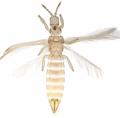Anaphothrips obscurus
Recognition data
Distinguishing features
Female fully winged or with wings no longer than thorax width. Body and legs mainly yellow with light brown markings, posterior margin of head brown; antennal segments V–VIII light brown; forewing weakly shaded. Antennae 8 to 9-segmented, segment VI with an incomplete oblique suture; segments III–IV with small forked sensorium. Head and pronotum without long setae. Metanotum reticulate, median setae well behind anterior margin. Forewing (when developed) with veinal setae shorter than half of wing width, first vein with 2 setae distally, second vein with 8–10 equally spaced setae. Abdominal tergites medially with faint transverse reticulate lines; tergite VIII with posteromarginal comb complete, but microtrichia short and variable.
Male, known only from Iran, with curved pore plate on sternites III–VII.
Variation
Adults commonly lack long wings, and the short wings of micropterous adults are easily overlooked. Body color is also variable with teneral adults more yellow, but overwintering adults considerably darker.
Related and similar species
Almost 80 species from around the world are currently placed in the genus Anaphothrips, of which 17 are known from North America, all living on grasses (Nakahara, 1995), and 43 from Australia, mostly living on plants other than grasses (Mound & Masumoto, 2009). The species are structurally very similar to each other, although A. obscurus is unusual in having lines of sculpture medially on the tergites. The male of this species has been identified and described from Iran (Mirab-Balou & Chen, 2010).
Taxonomic data
Current valid name
Anaphothrips obscurus (Müller)
Original name and synonyms
- Thrips obscurus Müller, 1776: 96
- Limothrips poaphagus Comstock, 1875: 120
- Thrips striata Osborn, 1883: 155
- Anaphothrips virgo Uzel, 1895: 148
- Anaphothrips collaris Priesner, 1926: 185
- Anaphothrips grisea Priesner, 1926: 185
- Anaphothrips sexguttus Girault, 1928: 1
- Anaphothrips discrepans Bagnall, 1923: 651
Family placement
Thripidae, Thripinae
Biological data
Life history
Feeding and breeding only on leaves, commonly in the leaf axils.
Host plants
Grasses and various cereal crops, including Avena, Hordeum, Secale, Triticum and Zea (Poaceae)
Tospoviruses vectored
None
Crop damage
Feeding on young leaves results in yellow streaks as the leaves mature.
Distribution data
Area of origin
Possibly Western Asia
Distribution
Worldwide in temperate areas











